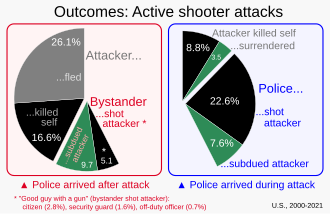Police use of deadly force in the United States
[11][12] Although Congress instructed the Attorney General in 1994 to compile and publish annual statistics on police use of excessive force, this was never carried out, and the Federal Bureau of Investigation does not collect these data.
[14] This has led multiple non-governmental entities to attempt to create comprehensive databases of police shootings in the United States.
[19] In part due to the lack of participation from state and local agencies, the Bureau of Justice Statistics stopped keeping count in March 2014.
[21] The FBI maintains the Uniform Crime Reporting Program (UCR), which relies on state and local law enforcement agencies voluntarily submitting a SHR.
The authors concluded that "reliable estimates of the number of justifiable homicides committed by police officers in the United States do not exist.
[19] An additional bill requiring all American law enforcement agencies to report killings by their officers was introduced in the U.S. Senate in June 2015.
[24] According to the Centers for Disease Control and Prevention (CDC), based on data from medical examiners and coroners, killings by law enforcement officers (not including legal executions) was the most distinctive cause of death in Nevada, New Mexico, and Oregon from 2001 to 2010.
[27] Mainly following public attention to police-related killings after several well-publicized cases in 2014 (e.g., Eric Garner, Michael Brown, and John Crawford III), several projects were begun to crowd-source data on such events.
[10] Around 2015–2016, The Guardian newspaper ran its own database, The Counted, which tracked US killings by police and other law enforcement agencies including from gunshots, tasers, car accidents and custody deaths.
[52] The table below gives recent CDC statistics showing the proportions of fatal police shootings and all firearm deaths by race.
[53] A 2016 working paper in the National Bureau of Economic Research by economist Roland G. Fryer, Jr. found that while overall "blacks are 21 percent more likely than whites to be involved in an interaction with police in which at least a weapon is drawn" and that in the raw data from New York City's Stop and Frisk program "blacks and Hispanics are more than fifty percent more likely to have an interaction with police which involves any use of force" after "[p]artitioning the data in myriad ways, we find no evidence of racial discrimination in officer-involved shootings.
[6] Nobel-laureate James Heckman and Steven Durlauf, both University of Chicago economists, published a response to the Fryer study, writing that the paper "does not establish credible evidence on the presence or absence of discrimination against African Americans in police shootings" due to issues with selection bias.
[57] A January 2017 report by the DOJ found that the Chicago Police Department had "unconstitutionally engaged in a pattern of excessive and deadly force".
A different, independent task force created by then-mayor Rahm Emanuel, stated that Chicago police "have no regard for the sanctity of life when it comes to people of color.
[65] An early study, published in 1977, found that a disproportionately high percentage of those killed by police were racial minorities compared to their representation in the general population.
The latter study hypothesized that concern with being perceived as racially biased decreased officers willingness to use deadly force against black suspects.
[75] Following this decision, police departments across the United States adopted stricter policies regarding the use of deadly force, as well as providing de-escalation training to their officers.
[76] A 1994 study by Dr. Abraham N. Tennenbaum, a researcher at Northwestern University, found that Garner reduced police homicides by sixteen percent since its enactment.
[76] For cases where the suspect poses a threat to life, may it be the officer or another civilian, Graham v. Connor (1989) held that the use of deadly force is justified.
"[75] Kathryn Urbonya, a law professor at the College of William & Mary, asserts that the Supreme Court appears to have two interpretations of the term 'reasonable:' one on the basis of officers being granted qualified immunity, and the other on whether the Fourth Amendment is violated.
[78] Qualified immunity, in particular, "shields an officer from suit when [he or] she makes a decision that, even if constitutionally deficient, reasonably misapprehends the law governing the circumstances [he or] she confronted.

